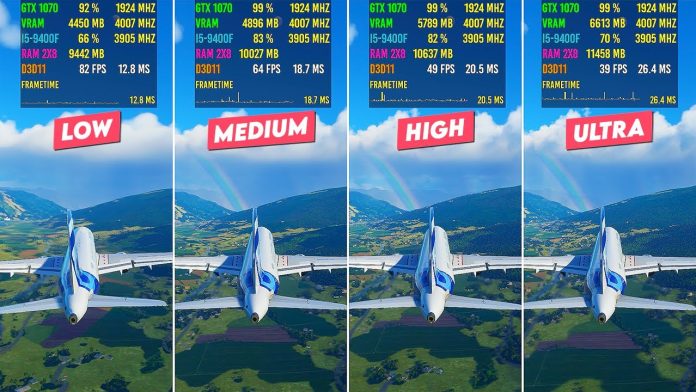Microsoft Flight Simulator is a beloved franchise cherished by simulation and aviation enthusiasts. The 2020 edition, developed by Asobo Studio and published by Xbox Game Studios, offers a visually stunning experience with its use of precise geographic data, advanced cloud computing, and real-time weather statistics. In addition to it’s lifelike simulation, the game allows you to explore diverse landscapes with unparalleled realism. To fully appreciate the breathtaking visuals, it’s recommended to play Microsoft Flight Simulator 2020 in 1080P resolution at 60 frames per second (FPS). This guide will walk you through the steps to optimize your settings for a smooth and immersive gaming experience.
System Requirements:
Before diving into the settings, ensure that your system meets the minimum requirements for playing Microsoft Flight Simulator 2020 at 1080P and 60 FPS. Here are the recommended specifications:
Minimum System Requirements:
- CPU: Intel Core i5-4460 or AMD Ryzen 3 1200 or higher
- Operating System: Windows 10 64-bit
- RAM: 8 GB
- Graphics Card: Radeon RX 570 or GeForce GTX 770
- Dedicated Video RAM: 2 GB
- Disk Space: 150 GB
Recommended System Requirements:
- CPU: Intel Core i5-8400 or AMD Ryzen 5 1500X or higher
- Operating System: Windows 10 64-bit
- RAM: 16 GB
- Graphics Card: Radeon RX 590 or GTX 970
- Dedicated Video RAM: 4 GB
- Disk Space: 150 GB
Why 60 FPS Matters
Frames Per Second (FPS) refers to the number of images displayed per second. Our eyes perceive visual signals at a specific rate, and experts suggest that most people can see between 30 and 60 FPS. For gamers, higher FPS can greatly impact gameplay and overall experience. In the case of Microsoft Flight Simulator, playing in 1080P at 60 FPS ensures a smoother and more realistic visual experience as you explore the world.
Key Configurations for 60 FPS in 1080P Microsoft Flight Simulator
- Ensure Game and Windows Updates: Make sure your Microsoft Flight Simulator 2020 is updated to the latest version. Also, keep your Windows operating system up to date by installing any available updates.
- Close CPU and GPU-Intensive Applications: Before running the game, close any CPU or GPU-consuming applications running in the background. Open the Task Manager and end any tasks that might hinder performance.
- Install the Game on an SSD: If you have a solid-state drive (SSD), consider installing the game on it. This can significantly improve performance and reduce loading times.
- Update Graphics Drivers: Update your graphics driver to the latest version. If you have an Nvidia GPU, you can use “GeForce Experience” to check for and download updates. Alternatively, you can manually update the driver through the Device Manager.
In-Game Alterations:
- Display Mode: Choose either “Windowed” or “Fullscreen” from the “Display Mode” option. This choice doesn’t affect performance but provides personal preference.
- Disable V-Sync: Turn off the V-Sync option in the game settings. V-Sync synchronizes the frame rendering with your monitor’s refresh rate and can introduce input lag.
- Render Scaling: Keep the Render Scaling at 100% for optimal image clarity. Adjusting it lower may result in a blurry appearance.
- Anti-Aliasing: Select “TAA” (Temporal Anti-Aliasing) as the Anti-Aliasing option. TAA provides the best balance between image quality and performance.
- Terrain Level: Adjust the Terrain Level setting based on your system’s capabilities. Higher settings correspond to more detailed terrain rendering but may impact performance. Find the setting that works best for you.
- Buildings, Trees, and Grass: Set “Buildings” and “Trees” to “Medium” for better performance. However, if you have a high-end GPU, you can increase these settings to “High” for improved visual quality. Keep the “Grass and Bushes” setting at “Medium” to maintain a balanced appearance.
- Object Level of Detail: Modify the “Object Level of Detail” setting based on your system’s capabilities. Increasing it enhances the rendering of individual objects but may impact performance. Adjust it to find the right balance.
- Other Settings: For the following settings, set them as follows for optimal performance and visual quality:
- Volumetric Clouds: High
- Texture Resolution: Medium
- Anisotropic Filtering: 16X
- Texture Supersampling: 2×2 (4×4 for higher-end GPUs)
- Texture Synthesis: Medium
- Water Waves: High
- Shadow Maps: High
- Terrain Shadows: High
- Contact Shadows: High
- Windshield Effects: High or Ultra
- Ambient Occlusion: High or Ultra
- Reflections: High
- Light Shafts: High
- Bloom, Depth of Field, Lens Flare: Ultra
- Generic Plane Models: Off (for multiplayer mode)
Nvidia Control Panel Settings(Nvidia GPU Users)
If you have an Nvidia GPU, you can further optimize performance by adjusting the following settings in the Nvidia Control Panel:
- Vertical Sync: On
- Anti-Aliasing-Gamma Correction: Off
- Anti-Aliasing-FXAA: Off
- CUDA GPUs: All
- Power Management: Prefer Maximum Performance
- Triple Buffering: Off
- Shader Cache: On(Disable if using an SSD)
Note: Remember to periodically update your system and graphics drivers to ensure the best performance and compatibility with the game.
Conclusion
Microsoft Flight Simulator 2020 provides a captivating virtual exploration of the world, especially during times when physical travel is limited. By following the recommended settings outlined in this guide, you can enjoy the game in 1080P at 60 FPS, immersing yourself in its picturesque landscapes and the thrill of aviation. Unlock the beauty of the virtual world and embark on your ultimate escape. Have a fantastic time!
Experiencing difficulties with your Device, check out our “How To” page on how to resolve some of these issues.














